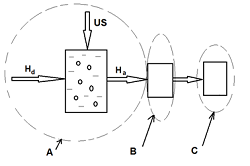Control of the Nanoparticles Content in Cosmetic Medicines
Abstract
The safety of nanoparticles used in medical cosmetology and dermatology raises significant concerns. One of the tasks of analyzing the concentration of nanoparticles that must be solved for the practical analysis of the quality of products with nanoparticles is the quantitative analysis of the content of nanoparticles. The previously developed acousto-magnetic method (AMM) for determining the concentration of APIs as magnetic nanoparticles can be used to determine the nanoparticles' concentration when samples are prepared as a colloidal solution. It is shown that the described method not only can be applied for quality control in cosmetology and dermatology but also can be simplified by using a less sensitive magnetometer, which makes this direct method more available in the entire range of values of the concentration of magnetic nanoparticles used in medical cosmetology and dermatology.
Full text article
References
2. Jain PK, Lee KS, El-Sayed IH, El-Sayed MA. Calculated absorption and scattering properties of gold nanoparticles of different size, shape, and composition: applications in biological imaging and biomedicine. J Phys Chem B. 2006;110(14):7238-48. doi:10.1021/jp057170o
3. Khlebtsov BN, Khanadeev VA, Khlebtsov NG. Determination of the Size, Concentration, and Refractive Index of Silica Nanoparticles from Turbidity Spectra. Langmuir. 2008;24(16):8964-70. doi:10.1021/la8010053
4. Liu X, Dai Q, Austin L, Coutts J, Knowles G, Zou J, et al. A one-step homogeneous immunoassay for cancer biomarker detection using gold nanoparticle probes coupled with dynamic light scattering. J Am Chem Soc. 2018;130(9):2780-2. doi:10.1021/ja711298b
5. De Giacomo A, Koral C, Valenza G, Gaudiuso R, Dell’Aglio M. Nanoparticle Enhanced Laser-Induced Breakdown Spectroscopy for Microdrop Analysis at subppm Level. Anal Chem. 2016;88(10):5251-7. doi:10.1021/acs.analchem.6b00324
6. Zhang R, Zhao H. Small-Angle Particle Counting Coupled Photometry for Real-Time Detection of Respirable Particle Size Segmentation Mass Concentration. Sensors. 2021;21(17):5977. doi:10.3390/s21175977
7. Mourdikoudis S, Pallares RM, Thanh NTK. Characterization techniques for nanoparticles: comparison and complementarity upon studying nanoparticle properties. Nanoscale. 2018;10:12871-934. doi:10.1039/C8NR02278J
8. Hurley KR, Ring HL, Kang H, Klein ND, Haynes CL. Characterization of Magnetic Nanoparticles in Biological Matrices. Anal Chem. 2015;87(23):11611-9. doi:10.1021/acs.analchem.5b02229
9. Khan I, Saeed K, Khan I. Nanoparticles: Properties, applications and toxicities. Arab J Chem. 2019;12(7):908-31. doi:10.1016/j.arabjc.2017.05.011
10. Bondarenko SI, Avrunin OG, Bondarenko IS, Krevsun AV, Koverya VP, Rakhimova MV. On the measurements of magnetic nanoparticle concentration in a biological medium using a superconducting quantum magnetometer. Low Temp Phys. 2020;46:1094. doi:10.1063/10.0002152
11. Avrunin OG, Bondarenko IS, Bondarenko SI, Semenets VV, inventors; Kharkiv National University of Radio Electronics, assignee. Method for the remote recognition of the manifestation of magnetic nanoparticles in a biological environment. Ukraine patent 137159. 2019 Oct 10 [cited 2021 Sep 10]. 19 p.
12. Smith RT, Jjunju FPM, Young IS, Taylor S, Maher S. A physical model for low-frequency electromagnetic induction in the near field based on direct interaction between transmitter and receiver electrons. Proc Math Phys Eng Sci. 2016;472(2191):20160338. doi:10.1098/rspa.2016.0338
Authors
Copyright (c) 2022 Marina Viktorivna Rakhimova, Igor Nikolaevich Bondarenko, Oleg Grigorovitsh Avrunin, Andrii I. Fedosov, Irina A. Sych, Vitaliy Dmitrievich Yaremenko, Olha O. Vislous, Lina O. Perekhoda

This work is licensed under a Creative Commons Attribution-ShareAlike 4.0 International License.
This work is licensed under a Creative Commons Attribution-ShareAlike 4.0 International License.
Authors continue to retain the copyright to the article if the article is published in the Borneo Journal of Pharmacy. They will also retain the publishing rights to the article without any restrictions.
Authors who publish in this journal agree to the following terms:
- Any article on the copyright is retained by the author(s).
- The author grants the journal the right of first publication with the work simultaneously licensed under a Creative Commons Attribution License that allows others to share work with an acknowledgment of the work authors and initial publications in this journal.
- Authors can enter into separate, additional contractual arrangements for the non-exclusive distribution of published articles (e.g., post-institutional repository) or publish them in a book, with acknowledgment of their initial publication in this journal.
- Authors are permitted and encouraged to post their work online (e.g., in institutional repositories or on their websites) prior to and during the submission process. This can lead to productive exchanges and earlier and greater citations of published work.
- The article and any associated published material are distributed under the Creative Commons Attribution-ShareAlike 4.0 International License.




